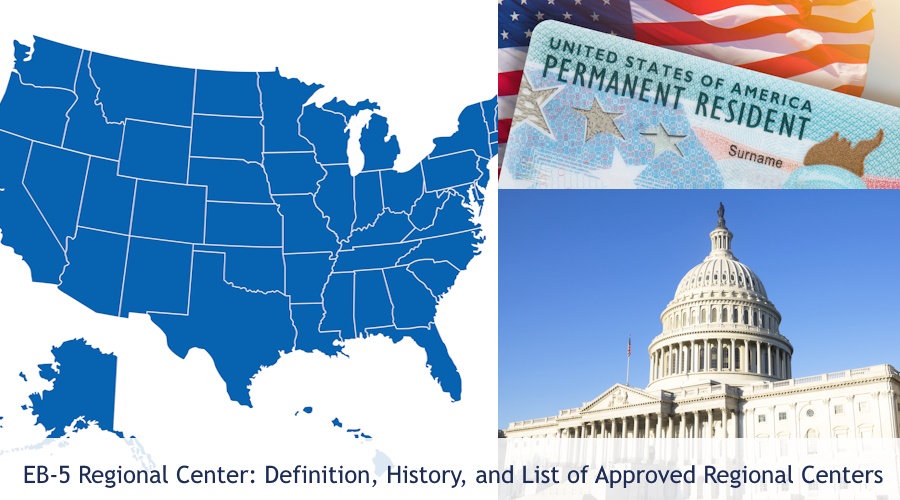 More than 95% of immigrant investors apply for a US Green Card through the EB5 Regional Center Program. From 1992 to 2020, Regional Centers have raised over $33 billion in EB-5 funding. This capital has helped sustain the U.S. economy and support thousands of American jobs.
More than 95% of immigrant investors apply for a US Green Card through the EB5 Regional Center Program. From 1992 to 2020, Regional Centers have raised over $33 billion in EB-5 funding. This capital has helped sustain the U.S. economy and support thousands of American jobs.
In this guide, we will cover the following topics about the EB5 Regional Center Program.
- What is an EB5 Regional Center?
- What is the History of EB5 Regional Centers?
- What are the Advantages of Investing in an EB5 Regional Center?
- What are the Differences between Regional Centers and Direct Investments?
- What are the Contributions of EB5 Regional Centers to the U.S. Economy?
- What is the Reauthorization of the EB5 Regional Center Program?
- What are the USCIS-approved Regional Centers?
At EB5 BRICS, we have successfully helped many families obtain US permanent residence through our partnership with accredited Regional Centers.
Table of Contents
What is an EB5 Regional Center?
An EB5 Regional Center is a public or private economic entity that promotes U.S. economic growth and creates jobs. An EB5 Regional Center must be designated by the U.S. Citizenship and Immigration Services (USCIS) to operate under the Immigrant Investor Visa Program. Regional Centers accept funding from immigrant investors to finance commercial EB5 Projects in the US and create jobs.

What is the History of EB5 Regional Centers?
The U.S. Congress created the EB5 Regional Center Program in 1992. The program was initially set to expire after 5 years. However, the Regional Center Program has been reauthorized multiple times since its implementation. The last reauthorization was on May 14, 2022, as part of the EB-5 Reform and Integrity Act (2022). Read more about i-924 petition.
What are the Advantages of Investing in an EB5 Regional Center?
Approximately 95% of immigrant investors apply for their EB-5 Green Card through regional center investment according to the U.S. Citizenship and Immigration Services (USCIS). The following advantages are the main reasons most EB 5 investors prefer investing in regional centers.

More Jobs Counted
You’re able to count more jobs from regional center projects compared to non-regional center investments. USCIS allows regional centers to use reasonable economic or statistical methodologies to count direct, indirect, and induced jobs toward the EB 5 Program requirements.
- Direct jobs are W-2 positions created by the operations of the new commercial enterprise (NCE) itself. For example, in a hotel project, the number of new full-time hotel staff is counted as direct job creation.
- Indirect jobs are created from the operations of the industries that supply goods and services to the new commercial enterprise. An example would be jobs generated by the construction costs of a regional center project.
- Induced jobs are those created from the positive economic impact of the regional center project in the area. One example of an induced job is a cashier position at a local store that opened because of the regional center project.
You must be credited with at least 10 full-time jobs to be eligible for permanent residency through the EB 5 Visa. Since more EB-5 jobs are considered under regional center projects, you and other investors in the project are more likely to meet the minimum employment requirements.
Simpler Investment Process
EB-5 investment is relatively simpler and easier through regional centers. Regional centers experienced in the EB-5 Program are made of an expert team of professionals. This is beneficial especially if you have minimal knowledge of the U.S. economy and laws.
Indirect Involvement
You don’t have to be directly involved in the operations and management of the regional center project as an immigrant investor. This is a big benefit for investors who wish to obtain a US investment green card while still pursuing other existing business and lifestyle goals. Moreover, investing in a regional center allows investors with limited business experience to leverage the expertise and knowledge of other industry specialists.
What are the Differences between Regional Centers and Direct Investments?
We will now compare the differences between regional centers and direct investment.
Investor Involvement
One of the distinct differences between regional center investors and direct project investors is the level of business involvement required. Investors in direct projects must actively manage and operate the business in the United States. You’ll have more control over the business and the decision-making process as a direct investor.
As an EB5 Regional Center investor, you’re usually designated as a limited partner along with other investors in the project. You won’t be directly involved in the management of the business but you’ll have voting rights and other privileges. This is advantageous if you have minimal experience in the U.S. market and want to focus on your other economic ventures.
Job Creation Calculation
With direct investments, only the full-time jobs created by the new commercial enterprise (NCE) will be counted toward the EB 5 requirements. These must be supported by evidence such as Form I-9 and W-2.
More jobs are considered for regional center investments. An economist writes an economic analysis demonstrating the anticipated number of EB 5 jobs to be created by the regional center project. Direct, indirect, and induced jobs are included in the job calculation for each investor involved in the EB5 Regional Center investment.
Investment Model and Options
You have more investment options as a regional center investor including real estate, hospitality, and infrastructure. Direct investments are usually limited to businesses like retail stores, franchises, and hotels. Additionally, direct projects can only obtain the eb5 investment amount from a single immigrant investor. In regional centers, multiple investors are involved. The pooled EB-5 investor capital is set up in an investment fund. Investors then purchase equity from this fund. The fund loans the EB 5 capital or purchases equity in the job-creating entity. The job-creating entity (JCE) then creates the required EB 5 jobs.
Application Form
The Reform and Integrity Act (RIA) of 2022 separated the initial petition to be filed by investors to initiate the EB-5 Visa process. Regional Center investors file Form I-526E (Immigrant Petition by Regional Center Investor). Direct investors file Form I-526 (Immigrant Petition by Standalone Investor).
Returns on Investment
Direct investors can expect higher returns on investment. On the other hand, returns from regional center investments have been historically low.
What are the Contributions of EB5 Regional Centers to the U.S. Economy?
Between 1992 and 2020, the EB5 Regional Center Program raised over $33 billion from immigrant investors according to Invest in the USA (IIUSA). This capital helped strengthen the U.S. economy, particularly during the 2008 financial crisis, and created thousands of jobs. Regional centers have an impact on a wide range of industries and sectors in the USA, such as wholesale trade, health care, education, renewable energy sources, senior living facilities, transportation, affordable housing, hotels, and research facilities.
What is the Reauthorization of the EB5 Regional Center Program?
The 2022 Reform and Integrity Act (RIA) reauthorized the Regional Center Program after it expired on June 30, 2021. The reauthorization of EB5 Regional Center is valid until September 30, 2027.
Here are other key changes brought on by the reauthorization of regional centers.
- The EB5 Regional Center Program will be extended for 5-year periods moving forward.
- Investors who file their eb5 green card petitions on or before September 30, 2026 are protected from future Regional Center Program expirations.
- Regional centers must use the new Form I-956 (Application for Regional Center Designation) to apply for USCIS accreditation. Form I-956G (Application for Regional Center Annual Statement) will be used to obtain ongoing accreditation for EB-5.
- All persons who are directly or indirectly involved with an EB 5 Regional Center and hold substantive authority in making operational or managerial decisions must file Form I-956H (Bona Fides of Persons Involved with Regional Center Program) with USCIS. These include board members, executives, general partners, administrators, and owners.
Under the RIA, regional centers must also contribute to the EB-5 Integrity Fund to help mitigate fraud and increase investor protection.
What are the USCIS-approved EB5 Regional Centers?
As of April 4, 2023, there are 640 regional centers approved by USCIS to operate under the EB 5 Visa Program. Below is a list of some of the USCIS-approved regional centers in the states with at least 1,000 regional center investors.
New York
- American Immigration Group-NYRC
- East Coast Regional Center, LLC
- Wealth Global Regional Center, LLC
California
- 1 America Regional Center
- Century American Regional Center
- EB-5 Impact Capital Regional Center, LLC
Florida
- EB5 Financing Management Company, LLC
- Florida Regional Center, LLC
- Green Card Solutions Regional Center
New Jersey
- Hudson Funds New York Regional Center, LLC
- Manhattan Metropolitan Regional Center
- New York EB-5 Regional Center, LLC
Pennsylvania
- EB5 Opportunities Fund, LLC
- Philadephia Industrial Development Corporation (PIDC) Regional Center
- Silverstein Properties Regional Center LLC
Texas
- Live in America-Texas Regional Center LLC
- Plymouth Park Regional Center, LP
- US EB5 Association
Maryland
- Capital Area Regional Center (CARC)
- DC Regional Center
- Northeast Regional Center, Inc.
Washington
- American Dream Group, LLC Regional Center
- Phoenix Pacific LLC
- Seattle Regional Center
Delaware
- Star EB5 Group
- Delaware Valley Regional Center, LLC
- Mid-Atlantic Regional Center
You can check the complete list of currently approved EB5 Regional Centers on the USCIS website.
EB5 BRICS is here to help guide you to citizenship by investment through the Regional Center Program. We have helped many families successfully invest in safe and secure Regional Center Projects. We are happy to answer your questions about EB-5 Processing Times and walk you through EB-5 step by step. We also assist with Direct investment options for EB5.
Make an appointment for a one-on-one session. Meet Vivek Tandon Esq. a US Lawyer and Investment Banker. Call Us for more information.
FAQs about EB5 Regional Center
Does an Immigration Lawyer work with an EB5 Regional Center?
Yes, your immigration lawyer works closely with the regional center you invested in to apply for your EB5 green card. Your immigration lawyer collaborates with the regional center to organize your documentation for your I-526E petition. These include the business plan, economic analysis, and financial reports.
What is the EB5 Regional Center Administration Fee?
The administration fee is a cost that investors pay for the services of the regional center. You need to allot between $50,000 to $70,000 in administration fees as a regional center investor.


